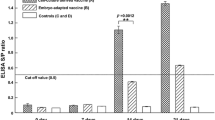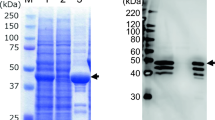Abstract
The current study was planned to develop an efficient vaccine against hydropericardium syndrome virus (HSV). Currently, formalin-inactivated liver organ vaccines failed to protect the Pakistan broiler industry from this destructive disease of economic importance. A field isolate of the pathogenic hydropericardium syndrome virus was adapted to chicken embryos after four blind passages. The chicken embryo-adapted virus was further serially passaged (12 times) to get complete attenuation. Groups of broiler chickens free from maternal antibodies against HSV at the age of 14 days were immunized either with 16th passage attenuated HSV vaccine or commercially formalized liver organ vaccine. The antibody response, measured by enzyme-linked immunosorbent assay was significantly higher (P < 0.05) in the group immunized with the 16th passage attenuated HSV vaccine compared to the group immunized with liver organ vaccine at 7, 14, and 21 days post-immunization. At 24 days of age, the broiler chickens in each group were challenged with 103.83 embryo infectious dose50 of pathogenic HSV and were observed for 7 days post-challenge. Vaccination with the 16th passage attenuated HSV gave 94.73% protection as validated on the basis of clinical signs (5.26%), gross lesions in the liver and heart (5.26%), histopathological lesions in the liver (1.5 ± 0.20), and mortality (5.26%). The birds inoculated with liver organ vaccine showed significantly low (p < 0.05; 55%) protection estimated on the basis of clinical signs (40%), gross lesions in the liver and heart (45%), histopathological lesions in the liver (2.7 ± 0.72), and mortality (35%). Birds in the unvaccinated control group showed high morbidity (84%), mortality (70%), gross (85%), and histopathological lesions (3.79 ± 0.14) with only 10% protection. In conclusion, this newly developed HSV vaccine proved to be immunogenic and has potential for controlling HSV infections in chickens.




Similar content being viewed by others
Abbreviations
- HPS:
-
Hydropericardium syndrome
- HSV:
-
Hydropericardium syndrome virus
- FAV-4:
-
Fowl adenovirus 4
- CAM:
-
Chorioallantoic membrane
References
Abdul-Aziz, T.A. and Al-Attar, M. A., 1991. New syndrome in Iraqi chicks, Veterinary Record, 129, 272
Afzal, M. and Ahmad, I., 1990. Efficacy of an inactivated vaccine against hydropericardium syndrome in broilers,Veterinary Record, 126, 59–60
Ahmad, K., Malik, M. I., Iqbal, K., Ahmad, K. and Naz, S., 1990. Efficacy of formalized liver organ vaccine against angara disease in broiler, Veterinary Archive, 63, 131–138
Akhtar, M., Ahmad, R., Hayat, C. S, Hussain, I. and Ashfaque, M., 2000. Comparative immune response of formalin inactivated and binary ethyleneimine inactivated Angara disease vaccines, Pakistan Journal Biology Science, 3, 1313–1314
Attrache, J. and Villegas, P., 2001. Genomic identification and characterization of avian adenovirus associated with inclusion body hepatitis, Avian Diseases, 45, 780–787
Anjum, A. D., Sabri, M. A. and Iqbal, Z., 1989. Hydropericarditis syndrome in broiler chickens in Pakistan, Veterinary Record, 124, 247–248
Cheema, A. H., Afzal, M. and Ahmad, J., 1989. An adenovirus infection of poultry in Pakistan, Review of Science and Technology Office International des Epizooties, 8, 789–795
Cowen, B. S., 1988. Chicken embryo propagation of type I avian adenoviruses, Avian Diseases, 32, 347–352
Duncan, D. B., 1955. Multiple range and multiple F tests, Biometrics,11, 1–42
Fadly, A. M. and Winterfield, R. W., 1975. Antigenic characterization of the inclusion body hepatitis virus, American Journal of Veterinary Research, 36, 532–534
Fadly, A. M. and Nazerian, K., 1984. Efficacy and safety of a cell culture live virus vaccine for hemorrhagic enteritis of turkeys: laboratory studies, Avian Diseases, 28, 183–196
Fadly, A. M., Nazerian, K., Nagaraja, K. and Below, G., 1985. Field vaccination against hemorrhagic enteritis of turkeys by a cell culture live virus vaccine, Avian Diseases, 29, 768–777
Ganesh, K., Suryanarayana, V., Raghavan, R. and Gowda, R. N., 2001. Nucleotide sequence of L1 and part of P1 of hexon gene of fowl adenovirus associated with hydropericardium hepatitis syndrome differs with the corresponding region of other fowl adenoviruses, Veterinary Microbiology, 78, 1–11
Ganesh, K., Suryanarayana, V. and Raghavan, R., 2002. Detection of fowl adenovirus associated with hydropericardium hepatitis syndrome by a polymerase chain reaction, Veterinary Research Communication, 26, 73–80
Grewal, G. S., Sharma, S. N. and Deka, B. C., 1981. Inclusion body hepatitis in broiler chickens, Indian Journal of Poultry Science, 16, 51–56
Grimes, T. M., King, D. J., Kleven, S. H. and Fletcher, O. J., 1977. Involvement of a type-8 avian adenovirus in the etiology of inclusion body hepatitis, Avian Diseases, 21, 26–33
Hitchner, S. B., 1980. Virus propagation in embryonating eggs. In: C. H. Domermuth, H. G. Purchase and J. E. Williams (eds), Isolation and Identification of Avian Pathogens. (American Association of Avian Pathologists, College Station, Texas), 120–121
Hussain, I., Anjum, A. A. and Izhar-ul-Haq., 1996. An oil emulsion vaccine against hydropericardium syndrome in broiler chickens, Pakistan Veterinary Journal, 16, 125–128
Hussain, I., Munir, R. and Ahmad, R., 1999. Evaluation and comparison of hydropericardium syndrome vaccines in broiler chicks, Pakistan Veterinary Journal, 19, 88–90
Itakura, C., Yasuba, M. and Goto, M., 1974. Histopathological studies on inclusion body hepatitis in broiler chickens, Japanese Journal of Veterinary Science, 36, 329–340
Kaur, A., Oberoi, M. S. and Singh, A., 1997. Neutralising antibody and challenge response to live and inactivated avian adenovirus-1 in broilers, Tropical Animal Health Production, 29, 141–146
Kawamura, H., Shimizu, F. and Tsubahara, H., 1964. Avian adenovirus: its properties and serological classification, National Institute of Animal Health Quarterly, 4,183–193
Khan, A. A., Sabri, A. N., Mansoor, M. K. and Hussain, I., 2005. Hydropericardium syndrome in Pakistan: a review, World’s Poultry Science Journal, 8, 647–654
Kim, J. N., Byun, S. H., Kim, M. J., Kim, J. J., Sung, H. W. and Mo, I. P., 2009. Outbreaks of hydropericardium syndrome and molecular characterization of Korean fowl adenoviral isolates, Avian Disease, 50, 526–530
Kumar, R., Chandra, R., Shukla, S. K., Agrawal, D. K. and Kumar, M., 1997. Hydropericardium syndrome in India: a preliminary study on the causative agent and control of the disease by inactivated autogenous vaccine, Tropical Animal Health Production, 29, 158–164
Lal, B., Maiti, N. K., Oberoi, M. S. and Sharma, S. N., 1992. An enzyme linked immunosorbent assay to detect antibodies against fowl adenovirus type-l, Indian Journal of Animal Science, 62, 35–37
Maiti, N. K. and Sarkar, P., 1997. Humoral immune response of chicks to different clinical isolates of avian adenovirus type-1, Comparative Immunology Microbiology and Infectious Diseases, 20, 59–62
Mansoor, M. K., Hussain, I., Arshad, M., Muhammad, G., Hussain, M. H. and Mehmood, M. S., 2009. Molecular characterization of fowl adenovirus serotype 4 (FAV-4) isolate associated with fowl hydropericardium-hepatitis syndrome in Pakistan, Pakistan Journal of Zoology, 41, 269–276
Manzoor, S. and Hussain, I., 2003. Reverse passive haemagglutination (RPHA) test for the detection and quantification of hydropericardium syndrome virus, Pakistan Journal of Life and Social Sciences, 1, 141–143
McFerran, J. B., McCracken, R. M., Connor, T. J. and Evans, R. T., 1976. Isolation of viruses from clinical outbreaks of inclusion body hepatitis, Avian Pathology, 5, 315–324
Naeem, K., Niazi, T., Malik, S. A. and Cheema, A. H., 1995. Immunosuppressive potential and pathogenecity of an avian adenovirus isolate involved in hydropericardium syndrome in broilers, Avian Diseases, 39, 723–728
Nakamura, K., Mase, M., Yamaguchi, S. and Yuasa, N., 2000. Induction of hydropericardium in one day old specific pathogen free chicks by adenoviruses from inclusion body hepatitis, Avian Diseases, 44,192–196
Norby, E. and Wadell, G., 1969. Immunological relationships between hexon of certain human adenoviruses, Journal of Virology, 4, 663–670
Nazerian, K and Fadly, A. M., 1982. Propagation of virulent and avirulent turkey hemorrhagic enteritis virus in cell culture, Avian Diseases, 26, 816–827
Ojkic, D. and Nagy, E., 2003. Antibody response and virus tissue distribution in chickens inoculated with wild-type and recombinant fowl adenoviruses, Vaccine, 22, 42–48
Roberts, M. M., White, J. L., Grutter, M. G. and Burnett, R. M., 1986. Three-dimensional structure of the adenovirus major coat protein hexon, Science, 232, 1148–1151
Russell, W. C., 2009. Adenoviruses: update on structure and function, Journal of General Virology, 90, 1–20
Sahidullah., Rahman, S., Rabbani, M., Shah, M. K., Naseem, S., Khan, S. H. and Muhammad, K., 2008. Development of standard protocols for preparation and evaluation of liver homogenate vaccines against hydropericardium syndrome virus in poultry, Pakistan Veterinary Journal, 28, 163–166
Sambrook, J and Russell, D., 2001. Molecular Cloning: A Laboratory Manual, 3rd edition, Cold Spring Harbor Laboratory Press, Cold Spring Harbor, NewYork
Schonewille, E., Singh, A.., T. Gobel, Gerner, W. W., Saalmuller, A.. and Hess, M., 2008. Fowl adenovirus (FAdV) serotype 4 causes depletion of B and T cells in lymphoid organs in specific pathogen-free chickens following experimental infection, Veterinary Immunology and Immunopathology, 121, 130–139
Schrenzel, M., Oaks, J. L. Rotstein, D. Maalouf, G. Snook, E. Sandfort, C. and Rideout, B., 2005. Characterization of a new species of adenovirus in falcons, Journal of Clinical Microbiology, 43, 3402–3413
Sheppard, M., McCoy, R. J. and Werner, W., 1995. Genomic mapping and sequence analysis of the fowl adenovirus serotype 10 hexon gene, Journal of General Virology, 76, 2595–2600
Toogood, C. I. A., Crompton, J. and Hay, R. T., 1992. Antipeptide antisera define neutralizing epitopes on the adenovirus hexon, Journal of General Virology, 73, 1429–1435
Acknowledgement
We acknowledge the financial support from the Pakistan Science Foundation under the project PSF #P-AU/Bio (367) entitled “Preparation of an in-vitro passaged live attenuated hydro-pericardium syndrome virus (local isolates) vaccine” is greatly appreciated. The authors are also thankful to the director of the Centre of Agricultural Biochemistry and Biotechnology for providing facilities for the present study. Technical assistance of Dr. Faisal Saeed Awan is highly acknowledged.
Author information
Authors and Affiliations
Corresponding author
Rights and permissions
About this article
Cite this article
Mansoor, M.K., Hussain, I., Arshad, M. et al. Preparation and evaluation of chicken embryo-adapted fowl adenovirus serotype 4 vaccine in broiler chickens. Trop Anim Health Prod 43, 331–338 (2011). https://doi.org/10.1007/s11250-010-9694-z
Accepted:
Published:
Issue Date:
DOI: https://doi.org/10.1007/s11250-010-9694-z




